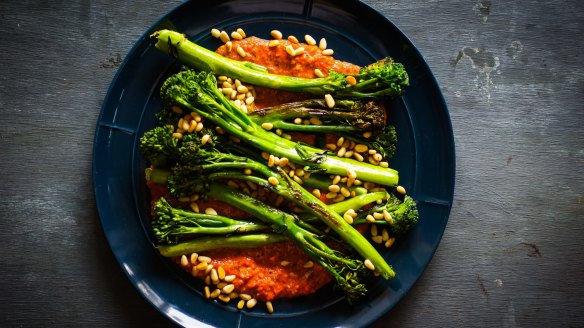Everything you need to know about ... romesco sauce

This centuries-old Catalan sauce is both rich and luxurious yet humble and traditional, the perfect partner to grilled seafood, meats and vegetables. It is used by chefs to bring colour and piquancy to the plate, yet is easy to make in the home kitchen.
What is it?
Romesco originates in Tarragona, south-west of Barcelona, and was originally made by pounding roasted garlic, tomato, red capsicum and nuts together in a mortar with a pestle. It developed in the 1700s, when tomatoes and peppers from the Americas became commonplace in Spain.

There is no one recipe. There are thousands, which differ from village to village, family to family. Native Mediterranean pine nuts were once used, but hazelnuts are now more common.
Anchovies and capers can be added, and the sauce thickened with bread. It is often dabbed onto grilled fish, used as a roux to thicken a fish stew, and even served with grilled lamb.
Why do we love it?
"My family is from the south of Spain, so I did not try it until I travelled Spain as a young adult," says MoVida's Frank Camorra.
"It is such a regional thing. One of the best is made in a restaurant west of Barcelona called Cal Xim. It's small, there's an open fire, and they serve it with escalivada – roasted eggplant, capsicum, and onion.
"The traditional recipe calls for nora peppers [a type of small, sweet sun-dried capsicum] but at MoVida, we grill ripe red capsicum over the wood grill for the smokiness and top this with a little smoky paprika. It is sensationally delicious."
In Sydney, Chiswick's head chef, Taylor Cullen, says: "What's not to love about romesco? It has such an intense flavour, such smooth texture."
He has made a non-traditional version with vegan fish sauce, sunflower seeds and molasses spread on eggplant and cooked in the wood-fired oven, but his more traditional version uses toasted almonds and whole grilled red capsicum – seeds, skin, pith and all.
"The pectin in the bits you normally throw out, when blended at high speed in the Vitamix (or Thermomix), makes a super smooth, creamy paste with a silky mouthfeel."
How do you use it?
- The late, great chef Jeremy Strode loved to put onions in his recipe and sweeten it with brown sugar to serve with plump prawns.
- Neil Perry makes a great romesco seasoned with sherry vinegar, which he serves with tender lamb cutlets.
- You can also use romesco to thicken a delicious traditional Catalan fish stew called romesco de peix.
- Katrina Meynink uses smoked almonds to add charry notes to romesco, which she serves with roasted broccolini.
Where do you get it?
You can easily make your own modern romesco sauce at home. In his cookbook Catalan Cuisine, Colman Andrews has an excellent traditional recipe that uses nora peppers and baked tomatoes. Some recipes call for the tomatoes and peppers to be slightly charred to add a rich smoky note.
Fresh romesco will last for 10 days in a sealed container in the fridge. Pre-made romesco is available from Frank Camorra's online food store Alimentaria. You'll find nora peppers at specialty food stores, Spanish and Mexican grocers or online.
Send your culinary conundrums and ingredient suggestions to brainfood@richardcornish.com.au or Twitter and Insta @foodcornish.
Appears in these collections
More:
From our partners
Original URL: https://www.brisbanetimes.com.au/goodfood/everything-you-need-to-know-about--romesco-sauce-20230222-h2a17t.html
